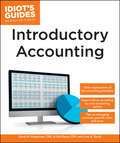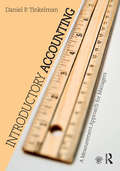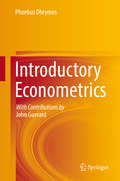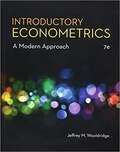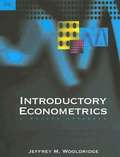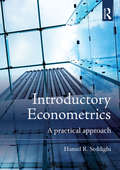- Table View
- List View
Introduction: Mastering the Merger
by David Harding Sam RovitThere is a right way and a wrong way to go about managing the deal-making process. The authors assert that it is possible to master the merger by responding effectively to four critical questions. This chapter introduces those questions and lays out the intent and structure of the book.
Introduction: New Career Opportunities for the Boomer Generation
by Tamara EricksonThe Boomer generation will be the first to enjoy a significant period of healthy, active non-childrearing adult life, and demographic shifts in the talent pool present mid-career workers with an important opportunity to rethink their relationship to work. This chapter offers Boomers the chance to step back and take a fresh look at life and career, and to consider the opportunities afforded them by the new world of work.
Introduction: Process Development as a Competitive Weapon
by Gary P. PisanoHow quickly and effectively a company can develop and implement novel process technologies increasingly shapes the overall cost, timeliness, and results of new product introductions, and the overall competitive success of the company. This chapter examines the strategic role of process development capabilities and discusses the significant influence of these capabilities on the company's competitive fortunes.
Introduction: Redefining Global Strategy
by Pankaj GhemawatThis chapter outlines an approach to global strategy that focuses on the differences across countries, and describes the book's central goal: to help businesses cross borders profitably by seeing the world as it really is, rather than in idealized terms. This chapter was originally published as the introduction to "Redefining Global Strategy: Crossing Borders in a World Where Differences Still Matter."
Introduction: Skillful Decision Making
by Clinton D. Korver Ronald A. HowardHow does a person systematically analyze situations to make clear and correct ethical decisions? We must master ethical distinctions to enable clear ethical thinking. We must commit in advance to ethical principles. And we must exercise disciplined decision-making skills to choose wisely. By learning a new way of thinking, in other words, we can all become skillful ethical decision makers.
Introduction: Strategy, Organizations, and Control
by Robert L. SimonsUnderstanding how to control empowered organizations in highly competitive markets is important for both theorists and practicing managers. In this chapter, the author introduces a new, comprehensive theory for controlling business strategy, illustrating how managers gain control of strategy using four basic levers.
Introduction: The Failure of Competition in the U.S. Health Care System
by Michael E. Porter Elizabeth Olmsted TeisbergThe fundamental problem in the U.S. health care system is that the structure of health care delivery is broken. This is what all the data about rising costs and alarming quality tell us. And the structure of health care delivery is broken because competition is broken. All of the well-intended reform movements have failed because they did not address the underlying nature of competition. This chapter outlines the issues at the core of the health care crisis in America, suggesting that the way to transform health care is to realign competition with value for patients.
Introduction: The New CMO--Why?
by David AakerMost organizations are rightly proud of the decentralized structures that keep managers close to customers and markets, ahead of competitors, and accountable for results. However, relying on unfettered decentralized organizations with highly autonomous silo units is no longer competitively viable. The world has changed. There is too much at stake to allow silo interests to inhibit or prevent the effort toward achieving strong brands and effective marketing. This chapter outlines the specific problems or missed opportunities that are created or worsened by the silo structure and the new role that the CMO must play in conquering these problems.
Introduction: What Does a World-Class Negotiating Organization Look Like?
by Lawrence Susskind Hallam MoviusSuccessful negotiations can make or break companies, and many companies have heavily invested in the training of their negotiators. However, until now, most negotiation training has failed to distinguish between individual negotiating skill and organizational negotiating capacity. In this chapter, the authors argue that understanding this difference and using it to create a solid negotiating structure is essential to an organization's negotiating success. This chapter was originally published as chapter 1 of "Built to Win: Creating a World-Class Negotiating Organization."
Introduction: What is the Medici Effect and How Can it Help Me Innovate?
by Frans JohanssonWhen you step into an intersection of fields, disciplines, or cultures you can combine existing concepts into a number of extraordinary new ideas. This chapter describes this phenomenon as "the Medici Effect," outlining how individuals, teams, and organizations can take advantage of it to ignite explosions of innovative ideas.
Introduction: What's the Point?--The Basics of Failure and Success in Negotiation Strategies
by Danny Ertel Mark GordonThe point of the deal is not simply "getting to yes" but forming strategic partnerships that last after the contracts are signed. This chapter introduces readers to essential concepts in negotiating.
Introduction: When Bad Things Happen to Good Teams
by Deborah Ancona Henrik BresmanWhy do bad things happen to good teams? Teams often fail because their members are following conventional models and theories that rely on the view that all a team needs to succeed is to focus within, on its own processes, on the problem at hand, and on each other as team members. The problem is that the world has changed and this model of internal focus doesn't work so well anymore. Being called to take a new leadership role, teams must become the eyes that read the changing environment, the people who bring commitment and energy to the task, the visionaries who help shape a new future, and the inventors of innovative solutions for business and world problems.
Introduction: When Conversations Go Wrong--Defining Confrontations
by Holly WeeksThe warfare, troubling emotions, and sheer uncertainty of difficult conversations can do real damage to people and their relationships. However, tough conversations usually fall apart in recognizable ways, and it's important to remember that good strategies and tactics can bring them into balance.
Introduction: Why Should Anyone Be Led by You?
by Gareth Jones Rob GoffeeLeaders at all levels make a difference to performance. They do so because they make performance meaningful. This chapter examines the modern obsession with the quest for authenticity, describing why authentic leadership in particular has become such a prized organizational and individual asset.
Introduction: Your Guide to Growth
by Scott D. Anthony Mark W. Johnson Joseph V. Sinfield Elizabeth J. AltmanThere is a general sense that a fog enshrouds the world of innovation, obscuring high-potential opportunities and making success a random and fleeting phenomenon. In contrast to conventional wisdom, this chapter contends that following the rights steps and putting in place the right structures can allow managers and entrepreneurs to improve significantly the odds of creating profitable growth businesses.
Introductory Accounting (Idiot's Guides)
by Lisa A. Bucki David H. Ringstrom Gail PerryAccurate accounting is the key to a successful business. But when you&’re dealing with assets and liabilities, profit and loss, and debits and credits, juggling all the numbers can quickly get confusing. Introductory Accounting gives you everything you need to know about basic financial accounting to manage your dollars and cents and keep your accounts in order. Ideal for small businesses, as well as any large company bookkeeper, this book covers:• Structuring your business and choosing an accounting method.• Setting up an accounting system and basic operating procedures (tracking sales, determining costs, managing cash, etc.).• Creating employee records, maintaining a payroll system, and accounting for benefits.• Keeping tax and benefit records.• Reporting costs.• Closing out cash journals and employee accounts at month-end and balancing ledgers.• Preparing month-end and year-end statements and reports. • Producing a balance sheet and monthly profit-and-loss (P&L) statements.• Using accounting software.
Introductory Accounting: A Measurement Approach for Managers
by Daniel P. TinkelmanIntroductory Accounting adopts a measurement approach to teaching graduate students the basics of accounting. Integrating both financial and managerial principles from the U.S. and around the globe, it links accounting to other areas of business (such as finance, operations, and management). Providing students with the context to understand how and why accounting is a valuable part of business, readers will gain an understanding of accounting’s role in financial analysis and managerial decision-making. Tinkelman discusses accounting as an imperfect measurement system, offering guidance on how quantitative data can benefit analysts and managers when used with an understanding of its limitations. The book is strongly grounded in research, and also draws on plenty of examples and cases to bring these issues to life. The conversational style of Introductory Accounting will appeal to MBA students, while key terms and illustrative problems make assignments easy for instructors. Additional materials for students and instructors are available on the book’s companion website.
Introductory Econometrics
by Humberto Barreto Frank M. HowlandThis highly accessible and innovative text and accompanying CD-ROM use Excel (R) workbooks powered by Visual Basic macros to teach the core concepts of econometrics without advanced mathematics. It enables students to run Monte Carlo simulations in order to understand the data generating process and sampling distribution. Intelligent repetition of concrete examples effectively conveys the properties of the ordinary least squares (OLS) estimator and the nature of heteroskedasticity and autocorrelation. Coverage includes omitted variables, binary response models, basic time series, and simultaneous equations. The authors teach students how to construct their own real-world data sets drawn from the internet, which they can analyze with Excel (R) or with other econometric software. The Excel add-ins allow students to draw histograms, to compute P-values and robust standard errors, and to construct their own MonteCarlo and bootstrap simulations. For more readers may visit the web site at www. wabash. edu/econometrics.
Introductory Econometrics
by Phoebus DhrymesThis book has taken form over several years as a result of a number of courses taught at the University of Pennsylvania and at Columbia University and a series of lectures I have given at the International Monetary Fund. Indeed, I began writing down my notes systematically during the academic year 1972-1973 while at the University of California, Los Angeles. The diverse character of the audience, as well as my own conception of what an introductory and often terminal acquaintance with formal econometrics ought to encompass, have determined the style and content of this volume. The selection of topics and the level of discourse give sufficient variety so that the book can serve as the basis for several types of courses. As an example, a relatively elementary one-semester course can be based on Chapters one through five, omitting the appendices to these chapters and a few sections in some of the chapters so indicated. This would acquaint the student with the basic theory of the general linear model, some of the prob#65533; lems often encountered in empirical research, and some proposed solutions. For such a course, I should also recommend a brief excursion into Chapter seven (logit and pro bit analysis) in view of the increasing availability of data sets for which this type of analysis is more suitable than that based on the general linear model.
Introductory Econometrics for Finance
by Chris BrooksThis best-selling textbook addresses the need for an introduction to econometrics specifically written for finance students. Key features: · Thoroughly revised and updated, including two new chapters on panel data and limited dependent variable models · Problem-solving approach assumes no prior knowledge of econometrics emphasising intuition rather than formulae, giving students the skills and confidence to estimate and interpret models · Detailed examples and case studies from finance show students how techniques are applied in real research · Sample instructions and output from the popular computer package EViews enable students to implement models themselves and understand how to interpret results · Gives advice on planning and executing a project in empirical finance, preparing students for using econometrics in practice · Covers important modern topics such as time-series forecasting, volatility modelling, switching models and simulation methods · Thoroughly class-tested in leading finance schools
Introductory Econometrics for Finance
by Chris BrooksA complete resource for finance students, this textbook presents the most common empirical approaches in finance in a comprehensive and well-illustrated manner that shows how econometrics is used in practice, and includes detailed case studies to explain how the techniques are used in relevant financial contexts. Maintaining the accessible prose and clear examples of previous editions, the new edition of this best-selling textbook provides support for the main industry-standard software packages, expands the coverage of introductory mathematical and statistical techniques into two chapters for students without prior econometrics knowledge, and includes a new chapter on advanced methods. Learning outcomes, key concepts and end-of-chapter review questions (with full solutions online) highlight the main chapter takeaways and allow students to self-assess their understanding. Online resources include extensive teacher and student support materials, including EViews, Stata, R, and Python software guides.
Introductory Econometrics for Undergraduates: A Student's Guide to the Basics
by Kacapyr EliaThoroughly classroom tested, this introductory text covers all the statistical topics that constitute a foundation for basic econometrics, with concise explanations of technical material.
Introductory Econometrics: A Modern Approach (Mindtap Course List Series)
by Jeffrey M. WooldridgeGain an understanding of how econometrics can answer today's questions in business, policy evaluation and forecasting with Wooldridge's INTRODUCTORY ECONOMETRICS: A MODERN APPROACH, 7E. Unlike traditional texts, this book's practical, yet professional, approach demonstrates how econometrics has moved beyond a set of abstract tools to become genuinely useful for answering questions across a variety of disciplines. The author has organized the book's presentation around the type of data being analyzed with a systematic approach that only introduces assumptions as they are needed. This makes the material easier to understand and, ultimately, leads to better econometric practices. Packed with relevant applications, the text incorporates more than 100 data sets in different formats. Updates introduce the latest developments in the field, including the recent advances in the so-called 'causal effects' or 'treatment effects,' to provide a complete understanding of the impact and importance of econometrics today.
Introductory Econometrics: A Modern Approach (Third Edition)
by Jeffrey M. WooldridgeThe modern approach of this text recognizes that econometrics has moved from a specialized mathematical description of economics to an applied interpretation based on empirical research techniques. It bridges the gap between the mechanics of econometrics and modern applications of econometrics by employing a systematic approach motivated by the major problems facing applied researchers today. Throughout the text, the emphasis on examples gives a concrete reality to economic relationships and allows treatment of interesting policy questions in a realistic and accessible framework.
Introductory Econometrics: A Practical Approach
by Hamid SeddighiThis book constitutes the first serious attempt to explain the basics of econometrics and its applications in the clearest and simplest manner possible. Recognising the fact that a good level of mathematics is no longer a necessary prerequisite for economics/financial economics undergraduate and postgraduate programmes, it introduces this key subdivision of economics to an audience who might otherwise have been deterred by its complex nature.

